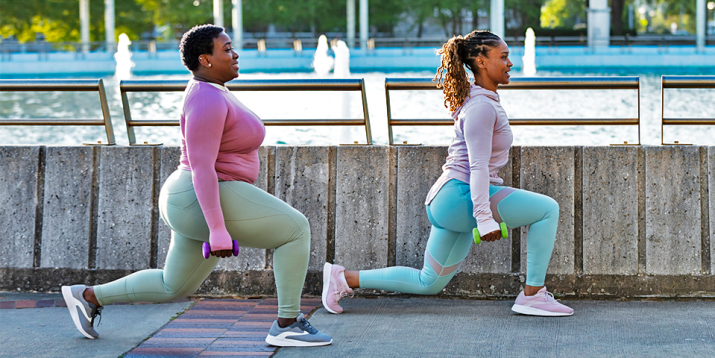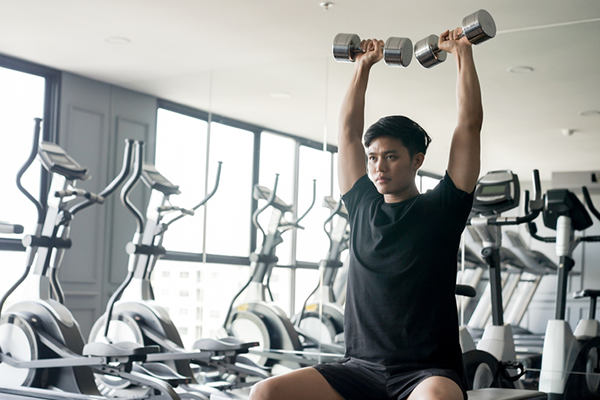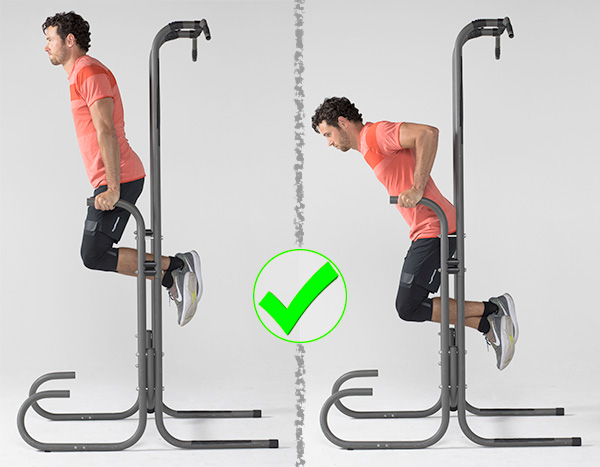10 of the Best Compound Exercises for Muscle and Strength

If you’re just starting out on your strength-building journey, you’ve probably happened across the term compound exercises, usually in the context of something you should be doing, like eating broccoli or watching PBS documentaries.
Exercise experts don’t agree on much, but nearly all of them agree that compound exercises are a strength-and-fitness seeker’s best friend.
“The bulk of the exercises in most people’s workouts should be compound,” says BODi Senior Director of Fitness and Nutrition Content Trevor Thieme, C.S.C.S.
The sooner you get to know these classic gym moves, the faster you’ll start making serious strides towards your goals.
What Are Compound Exercises?

“Compound exercises are moves that involve multiple joints and work multiple muscles or muscle groups simultaneously,” says Thieme.
Consider the overhead press — wherein you stand and push a weight straight above you from shoulder level. This is a perfect example of a multi-joint, or compound, exercise: As you lift and lower the weight, both your elbow and shoulder joints articulate substantially, engaging multiple muscle groups at the same time, and making it an efficient choice for a full-body workout.
By contrast, consider a lateral raise, in which you hold two dumbbells in front of your legs and raise them out to your sides.
A science type might tell you that other joints move too — the whole “foot bone’s connected to the ankle bone” concept — but, primarily, the movement occurs at your shoulder joints.
That makes it a single-joint, or isolation exercise.
So the bench press, push-up, squat, row, and lunge are all compound movements, whereas the biceps curl, dumbbell fly, and triceps extension are all isolation exercises.
Why Are Compound Exercises Important?
Why should you focus primarily on compound exercises in your workouts?
Isolation moves, after all, are more targeted, demand less coordination, and can generally entail lifting less weight.
So why not just build an entire fitness routine around them?
A few reasons…
1. They work more muscle
Back to our lateral raise–overhead press comparison: The focus of the lateral raise is a single muscle, specifically the medial (middle) head of your deltoid, or shoulder muscle.
The overhead press, by contrast, works not only all three heads of the deltoid, but also the triceps, and (to a lesser extent) the upper pectorals as well.
If you’re short on time, you can get a lot more work in by using compound movements.
2. They are more useful
“Muscles rarely work in isolation in the real world,” says Thieme. “So training them to work together is a more effective way to build functional strength.”
Functional strength exercises, he explains, build real-world strength and often resemble everyday movements.
Performing the squat is similar to standing up from a seated position, whereas doing an isolation move like the leg extension is similar to, well, nothing you’d typically do anywhere else besides the gym.
Both exercises build muscle — but compound exercises are more transferable to real-world activities.
3. They burn more calories
Because compound movements engage more muscle (a.k.a. “metabolically active tissue”) than isolation exercises, they also increase calorie burn to a greater extent.
As a result, a routine that includes the push-up, pull-up, deadlift, and lunge will ultimately burn more fat than one that includes the chest fly, straight arm row, hamstring curl, and leg extension.
4. They make you stronger
Since compound exercises engage more muscle than isolation exercises, they can be used to move heavier loads.
“That leads to greater ‘mechanical tension,’ which is a key growth stimulus,” says Thieme. “And the reason is that it creates more micro-damage within the muscle, which the body repairs and bolsters, making you stronger.”
10 of the Best Compound Exercises
Assuming you don’t have major injuries or movement restrictions, compound exercises should form the foundation your strength training workouts. Here are 10 that can help you maximize muscle growth from head-to-toe.
1. Dumbbell bench press
- Lie on a flat bench holding a pair of dumbbells directly above your chest with your palms facing forward.
- Keeping your feet flat on the floor, your core engaged, and your lower back pressed into the bench, slowly lower the weights to the sides of your chest, keeping your elbows at a 45 degree angle to your body (not flared).
- Pause, and then push the weights back up to the starting position.
Variations
Incline bench press: Performing this exercise on a bench set to a 30-degree angle emphasizes the upper pecs.
Barbell bench press: Swapping dumbbells for a barbell increases stability, allowing you to press more weight, but slightly reduces overall muscle recruitment.
2. Pull-up
- Grab a pull-up bar with an overhand grip that’s slightly beyond shoulder-width. Hang at arm’s length with your arms straight (a position known as a dead hang) and your ankles crossed behind you.
- Without swinging or kipping (using momentum to propel you upward), squeeze your shoulder blades together as you pull your chest to the bar (or at least your chin above it).
- Pause, and then lower yourself back to a dead hang.
Variations
Chin-up: Perform the move with an underhand grip.
Mixed-grip pull-up: Use an underhand grip with one hand and an overhand grip with the other. Mixing your grip forces your back, shoulders, and core to work harder to prevent you from rotating.
Negative pull-up: Position a chair, box, or bench so that when you stand on it and grab the bar with an overhand, shoulder-width grip, your arms are bent slightly. Simultaneously jump up and pull your upper chest to the bar with your legs pointed slightly in front of you. Pause, and then lower yourself slowly to a dead hang (try to take five seconds to do so). Step back on the chair, box, or step, and repeat.
3. Dumbbell deadlift
- Grab a pair of dumbbells and hold them at arm’s length in front of your thighs, palms facing back. This is the starting position.
- Keeping your back flat, chest up, and core braced, push your hips back and lower the weights to mid-shin level, keeping them close to your body (your hips should remain higher than your knees).
- Pause, and then return to the starting position.
Variation
Romanian deadlift: Perform the same movement keeping your legs mostly straight with just a slight bend in your knees.
4. Dip

- Grab the handles of a dip station and jump or step up to the starting position: arms straight, chest up, back flat, feet off the floor, and ankles crossed behind you. This is the starting position.
- Keeping your head neutral and arms close to your sides, bend your elbows until your upper arms are parallel to the floor.
- Pause, and then return to the starting position.
Variation
Incline dip: Instead of crossing your ankles behind you, raise your thighs in front of you, so that both your knees and hips form 90-degree angles. Hold your legs in that position for the duration of the exercise.
5. Seated military press
- Adjust an incline bench so the back is vertical and sit on the seat, holding two heavy dumbbells at shoulder height, palms facing forward.
- Keeping your back straight and core engaged, slowly press the dumbbells upward until your arms are straight.
- Lower your hands back to your shoulders and repeat.
Variations
Military press: Perform the exercise standing.
6. Loaded carry

- Stand holding two heavy dumbbells by your sides with your palms facing in. Brace your core (as if someone is about to punch you in the gut), and draw your shoulder blades back and down.
- Walk for 20 to 30 seconds to complete one “set.”
Variations
Suitcase carry: Perform the exercise carrying a single dumbbell in one hand. Alternate sides each set.
Overhead carry: Press two dumbbells directly above your shoulders so that your arms are straight and your biceps are by your ears (be sure to keep your back flat and core engaged). Hold that position as you walk.
7. Lunge
- Stand holding a pair of dumbbells at your sides, palms in, with your feet hip-width apart.
- Keeping your chest up, gaze forward, back flat, and core engaged, take a large step forward with your right foot and lower your body until your right thigh is parallel to the floor and your left knee is bent 90 degrees.
- Pause, and then return to the starting position.
- Repeat, this time stepping forward with the left foot. Continue alternating sides with each rep.
Variations
Reverse lunge: Instead of stepping forward, step backward into a lunge position, alternating sides each rep.
Side Lunge: Instead of stepping forward or backward, step sideways with your right foot, keeping your left leg straight and lowering your body until your right thigh is parallel to the floor. Alternate sides with each rep.
8. Push-up
- Get on all fours with your feet together, body straight from head to heels, and hands in line with (but slightly wider than) your shoulders. Squeeze your glutes and brace your core to lock your body into position.
- Keeping your elbows tucked toward your body and your head in line with your spine, lower your body until your chest is a few inches from the floor.
- Pause, and then push yourself back up to the starting position.
Variations
Incline push-up: Instead of placing your hands on the floor, place them on a stable, elevated surface (e.g., bench or low wall). The higher the surface, the easier the exercise becomes.
Decline push-up: Instead of placing your feet on the floor, place them on a stable, elevated surface. The higher the surface, the more difficult the exercise becomes.
9. Dumbbell row
- Stand with your feet hip- to shoulder-width apart, holding a dumbbell in each hand. Brace your core, hinge at your waist to push your hips back, bend your knees slightly, and lower your torso until it’s nearly parallel to the floor. Keep your glutes engaged to protect your lower back.
- Let the dumbbells hang at arms length with your palms facing each other. Engage your shoulder blades to keep your shoulders pulled back (i.e., don’t hunch). This is the starting position.
- Without moving your torso, and while keeping your elbows tucked and back flat, row the weights to your sides as you squeeze your shoulder blades together.
- Pause, and then lower the weights back to the starting position.
10. Dumbbell squat
- Stand holding a pair of dumbbells at your sides with your palms facing in, your feet shoulder-width apart, and toes pointed forward. This is the starting position.
- Keeping your back flat, chest up, and core engaged, push your hips back and bend your knees, lowering your body until your thighs are parallel to the floor.
- Pause, and then push yourself back up to the starting position.
